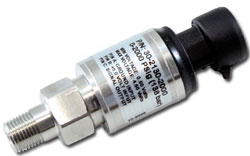
108-30-2130-100 Gauge style (PSIg) Pressure Sensors
AEM offers high quality PSIg sensors in 100, 150, 500, 1,000,
and 2,000. Gauge style pressure sensors reference pressure above atmospheric pressure. When exposed to atmospheric
pressure, gauge style pressure sensors will read 0 psig. Gauge style pressure sensors are commonly used for oil pressure,
fuel pressure, brake pressure, nitrous pressure etc.
Which Pressure Sensor is right for you?
There are many different tools that can be used for measurement, but the degree of accuracy is dependent upon the tool.
For example, a ruler can measure distance with a good degree of accuracy, but for a more precise measurement a caliper
should be used. The difference between a brass pressure sensor and a stainless steel pressure sensor is similar if
we think about it in these terms:
Brass Pressure Sensor = Ruler
Use a Brass Pressure Sensor where you need a good reference to what
pressure is being seen.
Example: Brass Pressure Sensor used for a Boost Gauge – Reference/Information for knowing
manifold pressure, not for ECU calibration.
Stainless Pressure Sensor = Caliper
Use a SS Pressure Sensor where you need exact details of the
pressure.
Example: MAP Sensor information for the ECU – Calibration/crucial information for the ECU.
|
|
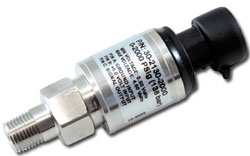
108-30-2130-1000 Gauge style (PSIg) Pressure Sensors
AEM offers high quality PSIg sensors in 100, 150, 500, 1,000,
and 2,000. Gauge style pressure sensors reference pressure above atmospheric pressure. When exposed to atmospheric
pressure, gauge style pressure sensors will read 0 psig. Gauge style pressure sensors are commonly used for oil pressure,
fuel pressure, brake pressure, nitrous pressure etc.
Which Pressure Sensor is right for you?
There are many different tools that can be used for measurement, but the degree of accuracy is dependent upon the tool.
For example, a ruler can measure distance with a good degree of accuracy, but for a more precise measurement a caliper
should be used. The difference between a brass pressure sensor and a stainless steel pressure sensor is similar if
we think about it in these terms:
Brass Pressure Sensor = Ruler
Use a Brass Pressure Sensor where you need a good reference to what
pressure is being seen.
Example: Brass Pressure Sensor used for a Boost Gauge – Reference/Information for knowing
manifold pressure, not for ECU calibration.
Stainless Pressure Sensor = Caliper
Use a SS Pressure Sensor where you need exact details of the
pressure.
Example: MAP Sensor information for the ECU – Calibration/crucial information for the ECU.
|
|
108-30-2056 The Universal 12 Position Trim Pot is for use on virtually any Engine Management System, such as the AEM EMS. Use the Trim
Pot to adjust a number of trims, including ignition timing, fuel, boost, etc. The Universal 12 Position Trim Pot includes:
12 Position Trim Pot with Flying Lead, 2 Brushed Silver Trim Position Decals with ranges from -5 to +6 and 0 to +11,
Blue/Red/Black AEM Logo Knob Decals & Blue/Red/Black Colored Knob Decals.
- Can be used with virtually any engine management system
- Includes a weatherproof-over-molded flying lead that has 12-inch insulated, color-coded wires, two brush silver Trim
Position decals, and black AEM logo adjustment knob
- Adjusts a number of trims, including ignition timing, fuel, boost, etc.
|
|
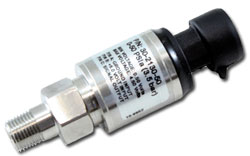
108-30-2130-15 Absolute (PSIa) Pressure Sensors
AEM offers high quality stainless steel PSIa sensors in 15 (1BAR),
30 (2BAR), 50 (3.5BAR), and 75 (5BAR). PSIa is referenced to absolute zero. Absolute zero is the pressure measurement
when all the pressure exerted by the atmosphere has been removed. The most common use for absolute pressure sensors
is reading manifold pressure. PSIa sensors are required if you wish to measure vacuum. A PSIa sensor will read about
14.7 PSI when the sensing element is exposed to atmospheric pressure at sea level however they can be recalibrated
to read zero at atmospheric and a negative number at values less than atmospheric pressure.
Which Pressure Sensor is right for you?
There are many different tools that can be used for measurement, but the degree of accuracy is dependent upon the tool.
For example, a ruler can measure distance with a good degree of accuracy, but for a more precise measurement a caliper
should be used. The difference between a brass pressure sensor and a stainless steel pressure sensor is similar if
we think about it in these terms:
Brass Pressure Sensor = Ruler
Use a Brass Pressure Sensor where you need a good reference to what
pressure is being seen.
Example: Brass Pressure Sensor used for a Boost Gauge – Reference/Information for knowing
manifold pressure, not for ECU calibration.
Stainless Pressure Sensor = Caliper
Use a SS Pressure Sensor where you need exact details of the
pressure.
Example: MAP Sensor information for the ECU – Calibration/crucial information for the ECU.
|
|
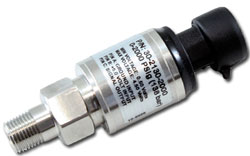
108-30-2130-150 Gauge style (PSIg) Pressure Sensors
AEM offers high quality PSIg sensors in 100, 150, 500, 1,000,
and 2,000. Gauge style pressure sensors reference pressure above atmospheric pressure. When exposed to atmospheric
pressure, gauge style pressure sensors will read 0 psig. Gauge style pressure sensors are commonly used for oil pressure,
fuel pressure, brake pressure, nitrous pressure etc.
Which Pressure Sensor is right for you?
There are many different tools that can be used for measurement, but the degree of accuracy is dependent upon the tool.
For example, a ruler can measure distance with a good degree of accuracy, but for a more precise measurement a caliper
should be used. The difference between a brass pressure sensor and a stainless steel pressure sensor is similar if
we think about it in these terms:
Brass Pressure Sensor = Ruler
Use a Brass Pressure Sensor where you need a good reference to what
pressure is being seen.
Example: Brass Pressure Sensor used for a Boost Gauge – Reference/Information for knowing
manifold pressure, not for ECU calibration.
Stainless Pressure Sensor = Caliper
Use a SS Pressure Sensor where you need exact details of the
pressure.
Example: MAP Sensor information for the ECU – Calibration/crucial information for the ECU.
|
|
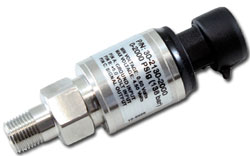
108-30-2130-2000 Gauge style (PSIg) Pressure Sensors
AEM offers high quality PSIg sensors in 100, 150, 500, 1,000,
and 2,000. Gauge style pressure sensors reference pressure above atmospheric pressure. When exposed to atmospheric
pressure, gauge style pressure sensors will read 0 psig. Gauge style pressure sensors are commonly used for oil pressure,
fuel pressure, brake pressure, nitrous pressure etc.
Which Pressure Sensor is right for you?
There are many different tools that can be used for measurement, but the degree of accuracy is dependent upon the tool.
For example, a ruler can measure distance with a good degree of accuracy, but for a more precise measurement a caliper
should be used. The difference between a brass pressure sensor and a stainless steel pressure sensor is similar if
we think about it in these terms:
Brass Pressure Sensor = Ruler
Use a Brass Pressure Sensor where you need a good reference to what
pressure is being seen.
Example: Brass Pressure Sensor used for a Boost Gauge – Reference/Information for knowing
manifold pressure, not for ECU calibration.
Stainless Pressure Sensor = Caliper
Use a SS Pressure Sensor where you need exact details of the
pressure.
Example: MAP Sensor information for the ECU – Calibration/crucial information for the ECU.
|
|

108-30-2130-30 Absolute (PSIa) Pressure Sensors
AEM offers high quality stainless steel PSIa sensors in 15 (1BAR),
30 (2BAR), 50 (3.5BAR), and 75 (5BAR). PSIa is referenced to absolute zero. Absolute zero is the pressure measurement
when all the pressure exerted by the atmosphere has been removed. The most common use for absolute pressure sensors
is reading manifold pressure. PSIa sensors are required if you wish to measure vacuum. A PSIa sensor will read about
14.7 PSI when the sensing element is exposed to atmospheric pressure at sea level however they can be recalibrated
to read zero at atmospheric and a negative number at values less than atmospheric pressure.
Which Pressure Sensor is right for you?
There are many different tools that can be used for measurement, but the degree of accuracy is dependent upon the tool.
For example, a ruler can measure distance with a good degree of accuracy, but for a more precise measurement a caliper
should be used. The difference between a brass pressure sensor and a stainless steel pressure sensor is similar if
we think about it in these terms:
Brass Pressure Sensor = Ruler
Use a Brass Pressure Sensor where you need a good reference to what
pressure is being seen.
Example: Brass Pressure Sensor used for a Boost Gauge – Reference/Information for knowing
manifold pressure, not for ECU calibration.
Stainless Pressure Sensor = Caliper
Use a SS Pressure Sensor where you need exact details of the
pressure.
Example: MAP Sensor information for the ECU – Calibration/crucial information for the ECU.
|
|
108-30-2063 AEM's wideband O2 UEGO AFR replacement sensor and stainless-steel, finned, stand-off bung kit includes only a replacement
Bosch 4.2 LSU Wideband UEGO sensor and stainless steel tall manifold bung. It is designed for installation and use
with the AEM 4-Channel Wideband UEGO Controller, and forced induction (turbo and supercharged) applications.
These sensors have a laser-etched, calibrated resistor in the sensor’s connector body. This resistor is specifically
created for the exact sensor that it is attached to. Modifying this will invalidate the sensor’s output. The wideband
sensor is laboratory-calibrated at the Bosch factory, accurate to 0.1 AFR and never requires free-air calibration
when used with an AEM wideband AFR controller.
- Accurate to 0.1 AFR
- Never requires free-air calibration when used with an AEM Controller and connector plug.
- Specifically designed for use with AEM Wideband UEGO controllers
- Includes sensor and weld-on stainless-steel tall manifold bung
|
|

108-30-2130-50 Absolute (PSIa) Pressure Sensors
AEM offers high quality stainless steel PSIa sensors in 15 (1BAR),
30 (2BAR), 50 (3.5BAR), and 75 (5BAR). PSIa is referenced to absolute zero. Absolute zero is the pressure measurement
when all the pressure exerted by the atmosphere has been removed. The most common use for absolute pressure sensors
is reading manifold pressure. PSIa sensors are required if you wish to measure vacuum. A PSIa sensor will read about
14.7 PSI when the sensing element is exposed to atmospheric pressure at sea level however they can be recalibrated
to read zero at atmospheric and a negative number at values less than atmospheric pressure.
Which Pressure Sensor is right for you?
There are many different tools that can be used for measurement, but the degree of accuracy is dependent upon the tool.
For example, a ruler can measure distance with a good degree of accuracy, but for a more precise measurement a caliper
should be used. The difference between a brass pressure sensor and a stainless steel pressure sensor is similar if
we think about it in these terms:
Brass Pressure Sensor = Ruler
Use a Brass Pressure Sensor where you need a good reference to what
pressure is being seen.
Example: Brass Pressure Sensor used for a Boost Gauge – Reference/Information for knowing
manifold pressure, not for ECU calibration.
Stainless Pressure Sensor = Caliper
Use a SS Pressure Sensor where you need exact details of the
pressure.
Example: MAP Sensor information for the ECU – Calibration/crucial information for the ECU.
|
|

108-30-2130-500 Gauge style (PSIg) Pressure Sensors
AEM offers high quality PSIg sensors in 100, 150, 500, 1,000,
and 2,000. Gauge style pressure sensors reference pressure above atmospheric pressure. When exposed to atmospheric
pressure, gauge style pressure sensors will read 0 psig. Gauge style pressure sensors are commonly used for oil pressure,
fuel pressure, brake pressure, nitrous pressure etc.
Which Pressure Sensor is right for you?
There are many different tools that can be used for measurement, but the degree of accuracy is dependent upon the tool.
For example, a ruler can measure distance with a good degree of accuracy, but for a more precise measurement a caliper
should be used. The difference between a brass pressure sensor and a stainless steel pressure sensor is similar if
we think about it in these terms:
Brass Pressure Sensor = Ruler
Use a Brass Pressure Sensor where you need a good reference to what
pressure is being seen.
Example: Brass Pressure Sensor used for a Boost Gauge – Reference/Information for knowing
manifold pressure, not for ECU calibration.
Stainless Pressure Sensor = Caliper
Use a SS Pressure Sensor where you need exact details of the
pressure.
Example: MAP Sensor information for the ECU – Calibration/crucial information for the ECU.
|
|

108-30-2130-75 Absolute (PSIa) Pressure Sensors
AEM offers high quality stainless steel PSIa sensors in 15 (1BAR),
30 (2BAR), 50 (3.5BAR), and 75 (5BAR). PSIa is referenced to absolute zero. Absolute zero is the pressure measurement
when all the pressure exerted by the atmosphere has been removed. The most common use for absolute pressure sensors
is reading manifold pressure. PSIa sensors are required if you wish to measure vacuum. A PSIa sensor will read about
14.7 PSI when the sensing element is exposed to atmospheric pressure at sea level however they can be recalibrated
to read zero at atmospheric and a negative number at values less than atmospheric pressure.
Which Pressure Sensor is right for you?
There are many different tools that can be used for measurement, but the degree of accuracy is dependent upon the tool.
For example, a ruler can measure distance with a good degree of accuracy, but for a more precise measurement a caliper
should be used. The difference between a brass pressure sensor and a stainless steel pressure sensor is similar if
we think about it in these terms:
Brass Pressure Sensor = Ruler
Use a Brass Pressure Sensor where you need a good reference to what
pressure is being seen.
Example: Brass Pressure Sensor used for a Boost Gauge – Reference/Information for knowing
manifold pressure, not for ECU calibration.
Stainless Pressure Sensor = Caliper
Use a SS Pressure Sensor where you need exact details of the
pressure.
Example: MAP Sensor information for the ECU – Calibration/crucial information for the ECU.
|
|
108-30-2014 AEM's Air Inlet Temperature Sensor Kits (AIT) senses the air temperature on the inlet side of the engine.
- Weatherproof connector
- Includes mating connector & pins
- Senses the air temperature on the inlet side of the engine
|
|
108-30-2010 AEM's Air Inlet Temperature Sensor Kits (AIT) senses the air temperature on the inlet side of the engine.
- Weatherproof connector
- Includes mating connector & pins
- Senses the air temperature on the inlet side of the engine
|
|
108-30-2001 AEM's Bosch 4.2LSU Wideband UEGO O2 replacement sensor kit includes only the sensor (with attached cable and
male connector) and is intended to replace an existing mounted wideband sensor used with AEM wideband air/fuel UEGO
controllers.
These sensors have a laser-etched, calibrated resistor in the sensor’s connector body. This resistor is specifically
created for the exact sensor that it is attached to. Modifying this will invalidate the sensor’s output. The wideband
sensor is laboratory-calibrated at the Bosch factory, accurate to 0.1 AFR and never requires free-air calibration
when used with an AEM wideband AFR controller.
- Accurate to 0.1 AFR
- Never requires free-air calibration when used with an AEM Controller and connector plug.
- Specifically designed for use with AEM Wideband UEGO controllers
- Replacement sensor only
For Digital Wideband UEGO Controller Part Number 108-30-4110 please refer to the 108-30-2004 Bosch LSU 4.9 Replacement UEGO Sensor
PN 108-30-2004.
|
|
108-30-2002 AEM's wideband UEGO air/fuel ratio sensor kit includes a Bosch 4.2 LSU Wideband UEGO sensor, connector plug, pins and plugs,
and mild steel O2 bung. This kit is designed to be an installation kit for a sensor used with an AEM wideband air/fuel
UEGO controller.
These sensors have a laser-etched, calibrated resistor in the sensor’s connector body. This resistor is specifically created
for the exact sensor that it is attached to. Modifying this will invalidate the sensor’s output. The wideband sensor
is laboratory-calibrated at the Bosch factory, accurate to 0.1 AFR and never requires free-air calibration when used
with an AEM wideband AFR controller.
- Accurate to 0.1 AFR
- Never requires free-air calibration when used with an AEM Controller and connector plug.
- Specifically designed for use with AEM Wideband UEGO controllers
- Includes sensor, weld-on bung, connector, wire seals and pins
|
|
108-30-2004 AEM's Bosch 4.9LSU Wideband UEGO O2 replacement sensor kit includes only the sensor (with attached cable and
male connector) and is intended to replace an existing mounted wideband sensor used with AEM Digital Wideband UEGO
Air/Fuel Controller Part Number 108-30-4110.
These sensors have a laser-etched, calibrated resistor in the sensor’s connector body. This resistor is specifically
created for the exact sensor that it is attached to. Modifying this will invalidate the sensor’s output. The wideband
sensor is laboratory-calibrated at the Bosch factory, accurate to 0.1 AFR and never requires free-air calibration
when used with an AEM wideband AFR controller.
- Accurate to 0.1 AFR
- Never requires free-air calibration when used with an AEM Controller and connector plug.
- Specifically designed for use with AEM Wideband UEGO controller Part Number 108-30-4110
- Replacement sensor only
All other AEM Wideband Controllers please refer to the 108-30-2001 Bosch LSU 4.2 Replacement Sensor
|
|
108-30-2201 AEM offers two Fuel Ethanol Content (Flex Fuel) Sensor Kits, one with 3/8” barbed adapter fittings and one with -6AN
to 3/8” adapter fittings (PN 108-30-2200 barbed fittings, PN 108-30-2201 -6AN fittings).
AEM’s Flex Fuel Ethanol Content Sensor Kits measure a vehicle’s fuel ethanol content percentage and fuel temperature,
which allows users with programmable engine management systems (capable of tuning for flex fuel) the ability to optimize
an engine’s tuning calibration for fuel ethanol content. While many gas stations label flex fuel as E85 (85% Ethanol
and 15% Gasoline), actual ethanol content can be much different. Using AEM’s Flex Fuel Ethanol Content Sensor delivers
the ability to determine the amount of fuel blend being used at any given time.
This sensor is ideal for use with AEM’s Infinity standalone programmable ECU & Series 2 EMS on flex-fuel equipped
vehicles, or it can be connected to a dash display or data logger.
|
|
108-30-2200 AEM offers two Fuel Ethanol Content (Flex Fuel) Sensor Kits, one with 3/8” barbed adapter fittings and one with -6AN
to 3/8” adapter fittings (PN 108-30-2200 barbed fittings, PN 108-30-2201 -6AN fittings).
AEM’s Flex Fuel Ethanol Content Sensor Kits measure a vehicle’s fuel ethanol content percentage and fuel temperature,
which allows users with programmable engine management systems (capable of tuning for flex fuel) the ability to optimize
an engine’s tuning calibration for fuel ethanol content. While many gas stations label flex fuel as E85 (85% Ethanol
and 15% Gasoline), actual ethanol content can be much different. Using AEM’s Flex Fuel Ethanol Content Sensor delivers
the ability to determine the amount of fuel blend being used at any given time.
This sensor is ideal for use with AEM’s Infinity standalone programmable ECU & Series 2 EMS on flex-fuel equipped
vehicles, or it can be connected to a dash display or data logger.
|
|
108-30-2064 AEM's Exhaust Backpressure install kit is specifically designed for use with AEM's 4-Channel Wideband UEGO Controller to
provide accurate air/fuel ratio readings from wideband O2 sensors that are mounted pre-turbo. The Exhaust Backpressure
install kit is engineered to provide backpressure readings without sacrificing sensor longevity due to extreme operating
conditions. The kit includes an AEM high performance stainless steel 100psig pressure sensor (Part# 108-30-2130-100), stainless
steel standoff tube, stainless steel braided hose and fittings.
- Allows you to mount wideband O2 sensors pre-turbo and get accurate AFR readings
- Designed to provide accurate pressure readings without sacrificing sensor longevity
- AEM High Performance Stainless Steel 100psig Sensor
- Stainless Steel standoff tube with fittings, braided hose and weld-on/threaded bung
- Includes all necessary hardware for ease of installation
|
|

108-30-2853 The tradeoff between adequate spark energy and adequate spark duration ends with AEM’s High-Output Inductive Coils, the
first inductive coils that deliver CDI-like spark energy and voltage, and the long spark duration necessary for vehicles
running high compression, high RPM, forced induction and/or nitrous engines.
Auto enthusiasts who have forced induction engines, high RPM engines or run nitrous oxide are aware of the compromises that
come with using inductive coils instead of converting to a Capacitive Discharge Ignition system (CDI). While inductive
coils deliver a long spark duration with simplicity, they lack the energy to adequately ignite the mixture in the combustion
chamber of a highly modified performance vehicle. Conversely, CDIs deliver an intense burst of spark energy, but with practically
no spark duration, which makes having the proper air/fuel mixture in the combustion chamber paramount for best performance.
This compromise ends with AEM’s High-Output IGBT “Smart” Inductive Coils.
AEM’s High-Output, Insulated Gate Bipolar Transistor (IGBT) “Smart” Inductive Coils are designed for use on applications
that do not have an external igniter.
|
|